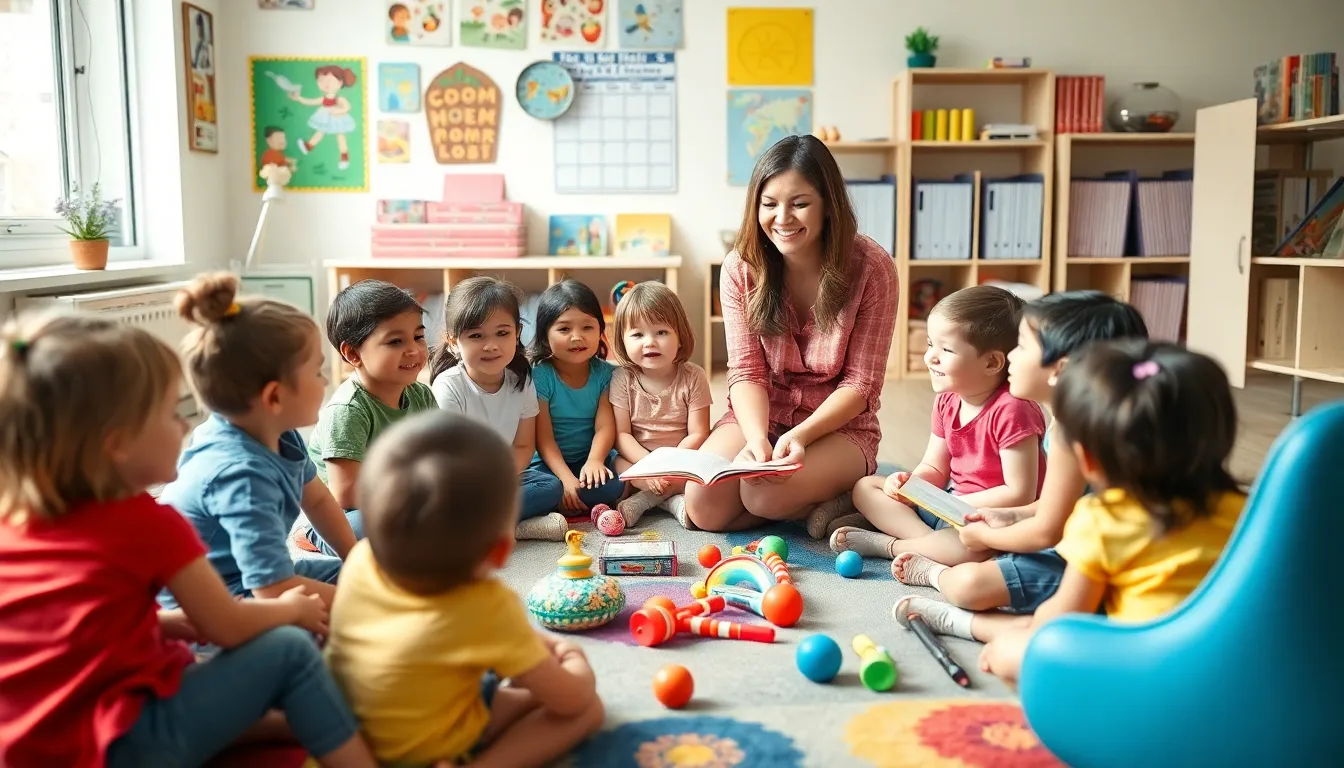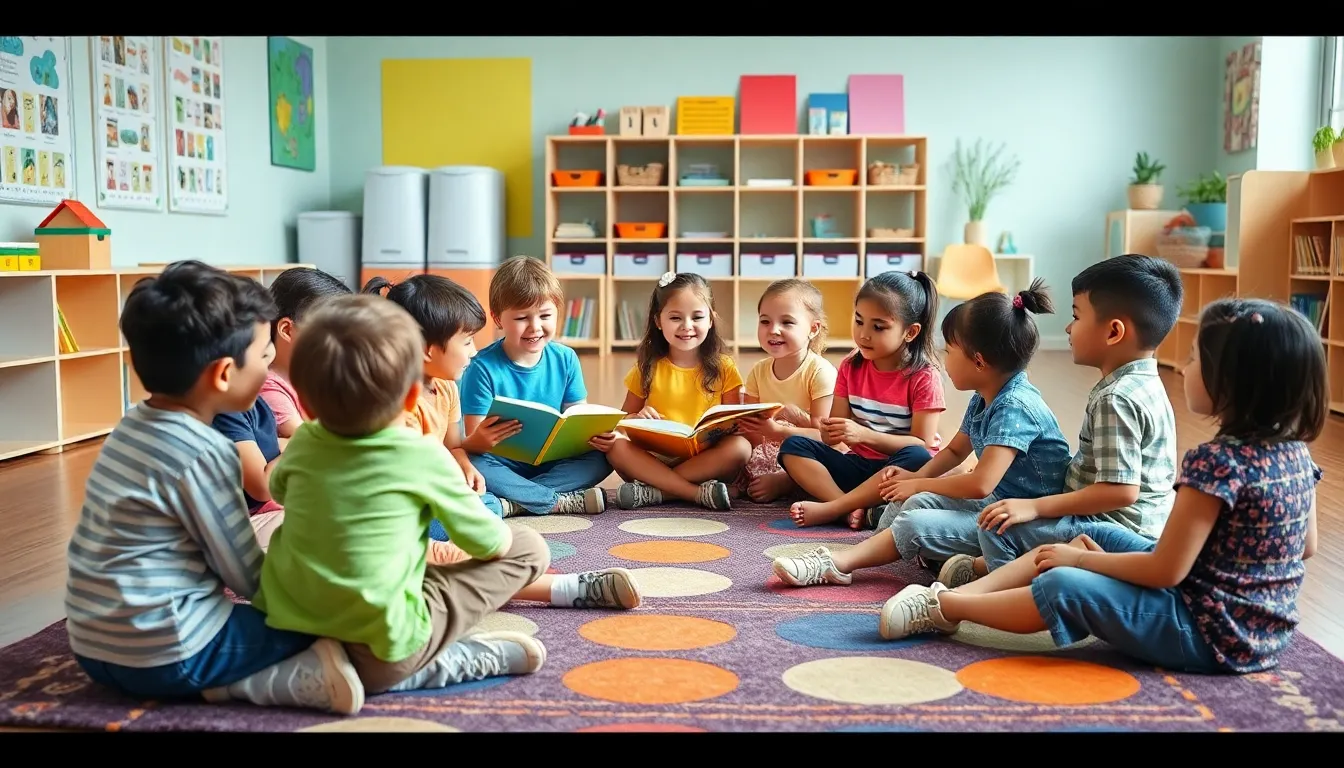Picture this: a cozy classroom filled with eager little faces, all gathered in a circle, ready to embark on a journey of learning and laughter. Classroom circle time isn’t just a daily ritual; it’s where magic happens. From sharing stories to sparking creativity, this lively gathering transforms the mundane into the extraordinary.
Table of Contents
ToggleOverview of Classroom Circle Time
Classroom circle time serves as an essential part of the daily routine for young learners. This interactive gathering encourages students to connect with each other and their teachers. Activities during circle time include singing songs, sharing stories, and discussing daily plans. These elements promote communication skills and enhance social development among children.
Engagement remains a key focus during this time. Educators often incorporate visual aids and props to enhance learning experiences. By using these tools, teachers facilitate better understanding and retention of concepts.
Additionally, circle time nurtures creativity. Children express their thoughts and ideas in a supportive environment. This open dialogue fosters confidence and encourages participation among all students.
Routine practices in circle time offer structure to the classroom environment. Consistency leads to familiarity, and children thrive on predictability. Each day’s activities can vary, but the overall format remains consistent, allowing students to feel secure.
Inclusivity is another critical aspect. Circle time invites contributions from every child, enabling diverse perspectives to emerge. Teachers create an atmosphere where all voices matter, fostering respect and valuing differences.
Overall, classroom circle time establishes a community feel within the classroom. Connections formed during this time often extend beyond the circle, influencing interactions throughout the day. This foundational practice ultimately shapes a positive learning environment for students.
Benefits of Classroom Circle Time
Classroom circle time offers several key benefits, enhancing various aspects of a child’s development.
Social Skills Development
Social skills flourish during circle time. Children engage in activities that require conversation, cooperation, and sharing. Through group discussions, they learn to listen actively and respect differing opinions. This environment promotes teamwork, allowing them to work together on projects or share personal stories. Additionally, interactions with peers strengthen their ability to build friendships. Educators often facilitate games that require turn-taking and collaboration, reinforcing these skills. Over time, children become more comfortable expressing themselves in social settings. Role-playing scenarios during circle time can also prepare them for real-world interactions.
Emotional Regulation
Emotional regulation hinges on the supportive atmosphere of circle time. Children often share their feelings, allowing them to recognize and articulate emotions. This practice helps in understanding their own feelings and those of others. Regular discussions about feelings work to foster empathy and connection. Techniques like deep breathing and mindfulness introduced during circle time can guide children in managing stress. Recognizing emotions in a safe space enables them to respond effectively in challenging situations. Through these activities, students learn adaptive strategies for navigating their emotions. Overall, circle time nurtures resilience and promotes emotional intelligence.
Effective Techniques for Implementing Classroom Circle Time
Implementing effective techniques during classroom circle time enhances student involvement and learning outcomes. A well-structured session promotes a seamless flow of activities.
Structuring the Circle Time Session
Organizing circle time starts with setting a clear agenda. Define specific goals for each session, such as sharing experiences or learning new concepts. Establishing time limits for each activity aids in maintaining focus. Incorporate a welcoming opening ritual, such as a song, to transition smoothly into the session. Create an environment that encourages participation by arranging seating in a circle, ensuring every child feels included. Encouragement of turn-taking fosters respect and patience among students, contributing to an orderly discussion. Finishing the session with a reflective closing activity reinforces learning and strengthens connections.
Engaging Students Actively
Active engagement captures student attention, encouraging participation. Utilizing visual aids, like puppets or charts, supports comprehension. Encouragement of hands-on activities creates a dynamic atmosphere and sparks curiosity. Asking open-ended questions stimulates critical thinking and invites opinions from students. Implementing games that reinforce concepts helps solidify understanding while making learning enjoyable. Encouraging children to share personal stories fosters a sense of belonging and community. Including mindfulness moments or breathing exercises allows students to center themselves, promoting focus. These strategies ensure that circle time remains an interactive experience, supporting social and emotional development effectively.
Challenges in Classroom Circle Time
Classroom circle time poses several challenges that educators encounter during implementation.
Common Obstacles
Distractions can disrupt the flow of circle time. Students may become restless or lose focus, especially in dynamic classroom environments. Some children may struggle with participation, feeling shy or unsure about sharing their thoughts. Another challenge is time management; fitting all planned activities into a limited timeframe creates stress. Additionally, varying developmental levels among students can make it difficult to engage everyone equally.
Solutions and Strategies
Implementing a few strategies helps overcome these obstacles. Establishing a clear agenda ensures that activities flow smoothly and time is allocated effectively. Using visual aids captures student attention and reinforces concepts. Encouraging peer support fosters an inclusive environment and boosts confidence among shy children. Introducing short, engaging activities helps maintain focus and allows for movement. Incorporating mindfulness techniques promotes emotional regulation and centers the group effectively, nurturing a sense of community.
Best Practices for Educators
Creating an effective classroom circle time requires planning and intentionality. Establish a structured agenda that outlines session objectives. Include a warm welcome ritual to set a positive tone and engage students.
Incorporating visual aids can significantly enhance understanding. Use props relevant to activities or topics being covered. Engage students with hands-on activities that encourage participation and creativity.
Seating arrangements play a vital role in fostering inclusivity. Arrange seating in a circle to promote a sense of belonging. Ensure that every child has the opportunity to contribute by encouraging turn-taking.
Utilize open-ended questions to stimulate critical thinking. Guide discussions that allow students to express opinions and share experiences. Foster teamwork through games and activities that encourage cooperation and collaborative skills.
Mindfulness moments can help students center themselves. Introduce brief breathing exercises to promote calmness before beginning the session. Techniques like these enhance emotional regulation and create a supportive environment.
Monitor student engagement throughout the session. Notice signs of restlessness and adapt activities accordingly. Adjusting the pace and incorporating short, engaging tasks can keep attention focused.
Addressing challenges is crucial in maintaining a productive circle time. Distractions can occur, so implementing visual aids can capture interest. Encouraging peer support creates opportunities for shy students to engage comfortably.
Define clear expectations regarding behavior and participation. Communicate these expectations at the start of each session. Reinforcement of positive behavior further nurtures a respectful and collaborative atmosphere.
Conclusion
Classroom circle time stands as a fundamental practice that enriches the educational experience for young learners. By fostering creativity communication and emotional intelligence it transforms the classroom into a vibrant community. This daily ritual not only nurtures social skills but also cultivates a sense of belonging among students.
Through structured activities and engaging techniques educators can effectively address challenges while maximizing participation. The benefits of circle time extend beyond the classroom as children develop essential skills that serve them well into the future. Embracing this practice creates a supportive environment where every child feels valued and empowered to express themselves.





